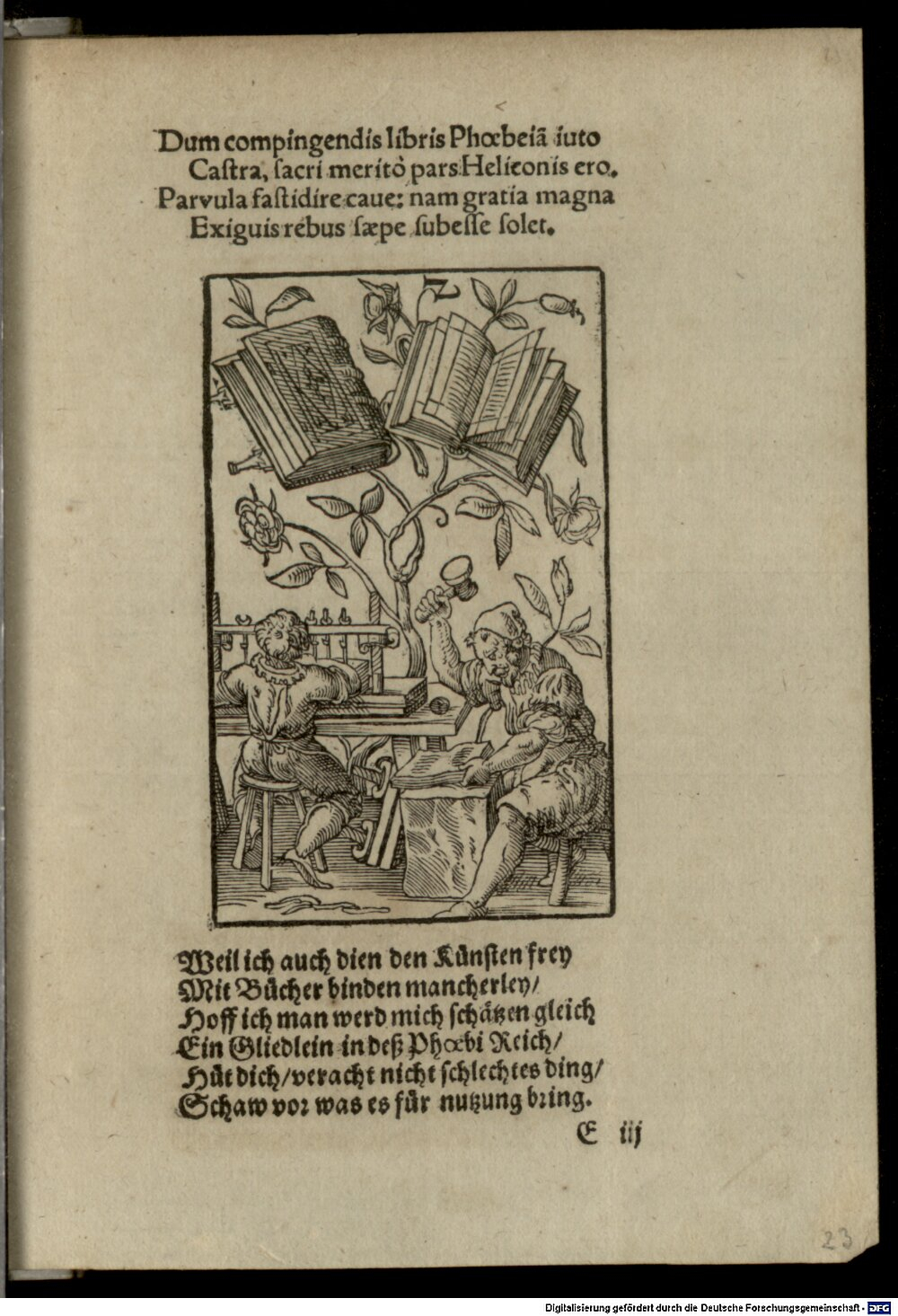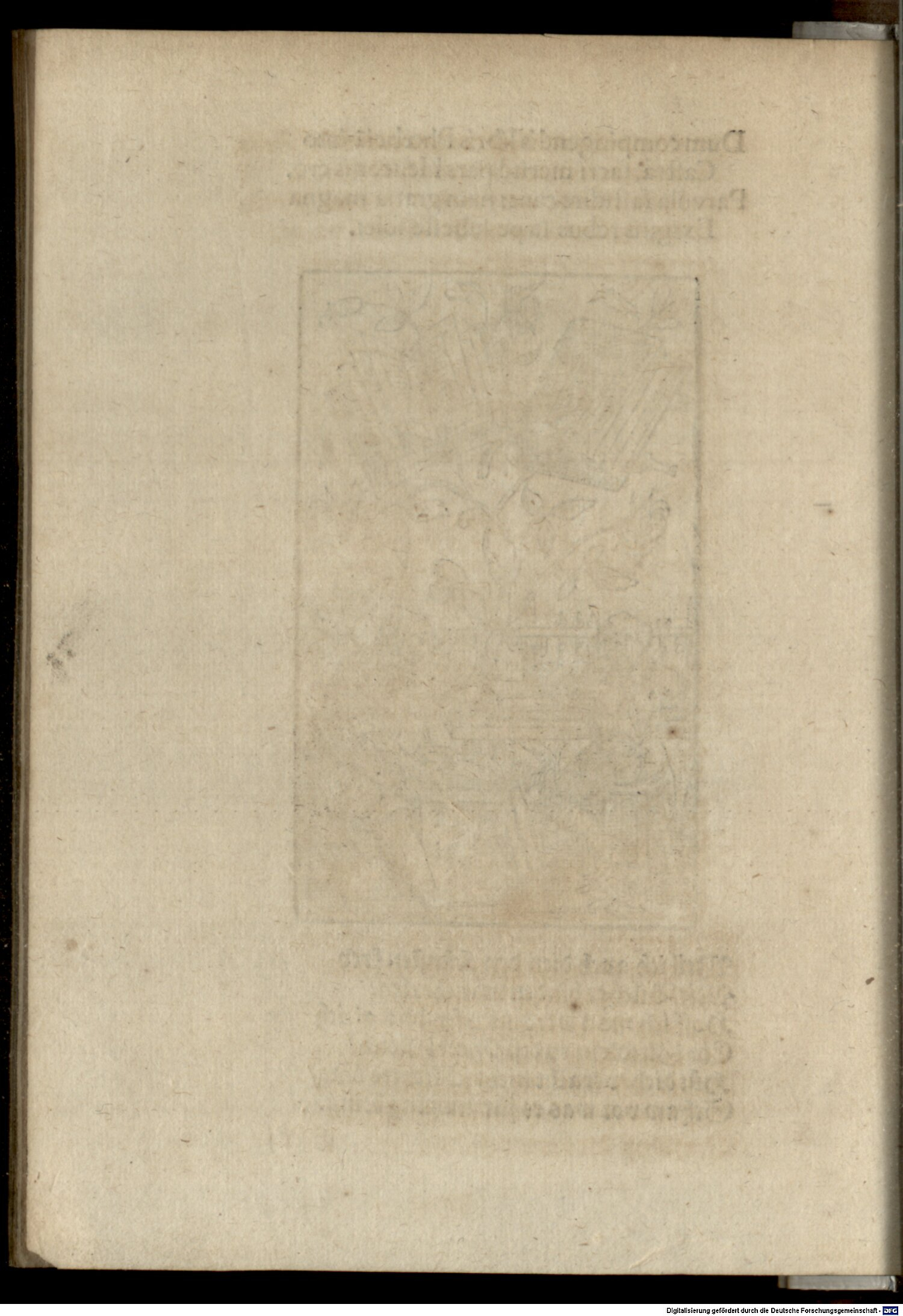
Jost Amman’s 1568 image of a bookbinder from his “Book of Trades” is quite well known, and a rich source of information about 16th century bookbinding. Not so well known is his 1588 “Two of Books”, which depicts two bookbinders, one sewing and beating a textblock. The images are in a playing card iconography. They originally appeared in a book, along with a poem in Latin and German.
Amman used a variety of suits that may seem odd to us now: books, printer’s ink balls, earthenware wine vessels, and metal drinking cups. Later, the French standardized the suits we now use: Hearts, Diamonds, Spades, and Clubs.

The “two of books” is extraordinary visual evidence for binders and book historians, since it depicts a sewer and beater in action. They arrangement is similar to the binders from the Book of Trades (Fig. 1) with a muscular seated foreground binder, actively ploughing or beating, and a sewer with his back to us in the background.
The sewer is using a Northern European style frame with hooks and what appears to be some kind of gated front on the very thick base. He sits almost parallel to the frame, with his left hand inside the book, his right hand free to pull the length of thread. A ball of thread or beeswax to his right. The shape of the nuts on the frame is typically German. A finishing press lies under the table, with the same typical nuts. In a bindery of the time, he would have likely been facing a window, to help aid needle placement when the signatures were partially open, so the fact that he is facing away from the viewer makes me think Amman possibly based his woodcut on a bindery he observed.
The beater is beating a partially folded textblock — two pages are clearly visible — likely to remove a previous folding crease when the book was transported from the printer to the binder. (1) It is a testament to his strength that he is able to do this strenuous activity while seated. The beating stone appears to be one solid piece. It is drawn distinctly different than the wood stumps in the Fig. 1. And of course they are not working in a bindery.
The books above them (Fig. 4) are all typical late Gothic, with thick wood boards, a heavy round to the spine and foreedge, typical panel tooling, and clasps. Accuracy in details that we know about lend credence to the validity of other aspects we know little about, like how the beater held the hammer and the fact he is seated rather than standing.
Each image in the book was originally accompanied by short verses in Latin and German. The two Peters (Zillig and Verheyen) provided a translation:
Because I too serve the liberal arts
By binding various/diverse books
I hope you will appreciate me
As a small link in Phoebe’s realm
Look here and see the benefits
Phoebe’s realm? Verheyen found that Phoebe (aka. Endymion, Diana, Cynthia) was an allegorical figure for spiritual ascent or apotheosis, which makes sense in the context cards in this deck, which generally represent the search for virtue in the material world. (3) Mary Carol Koester (Azalea Bindery) left an very interesting comment on my previous post about the two of printer’s ink balls from the same deck, noting that the “two” in a Tarot deck of cards concerns the transfer of oral to written history, which is mirrored in both these images of the material production of written texts.

Was this book intended to be converted into playing cards? The evidence is contradictory. Worldcat lists only three institutions holding it. I haven’t discovered any of the 1588 cards cut out of books, though I would love to know if any exist!
It is difficult to believe that the owner would cut out the cards. How could they be cut regular enough by ordinary means — a scissors or knife and straightedge — to be shuffled and dealt? And wouldn’t they worry about decreasing the value of an expensive book? Perhaps a professional would have done this, using something like the plough. The earliest table mounted playing card cutter I am aware of is 18 c . French.
Additionally, why letterpress print the poem only to have it discarded when cutting out the cards? Playing cards are usually printed on a sheet, then laminated with a paper core and a back. This was done for rigidity and durability, and to prevent the image from showing through on the back. Laminating one card at a time, after cutting it out of a book, would be very time consuming. And again, something the general public would be unable to do. Without laminating, is is quite easy to see through the page, at least enough to identify the card if you were familiar with them.

The images in the book certainly have all the standard iconography of playing cards, and they were printed only on the recto of the leaves, which is unusual, and does suggest they were meant to be cut out. The left over poems could have been cut out and used for other purposes, I suppose; hung on a wall or lining a coffer or small box.
Maybe there was a different dedicated card printing of his woodcuts on full size sheets for cutting into cards? I haven’t found one. This is where examining the originals might shed further light.

The image visually references the etymology of the word “book”, by portraying the books growing on a tree.
From Wikipedia: “The word book comes from Old English bōc, which in turn comes from the Germanic root *bōk-, cognate to ‘beech‘.[4] Similarly, in Slavic languages (for example, Russian, Bulgarian, Macedonian) буква (bukva—’letter’) is cognate with ‘beech’. In Russian, Serbian and Macedonian, the word букварь (bukvar’) or буквар (bukvar) refers specifically to a primary school textbook that helps young children master the techniques of reading and writing. It is thus conjectured that the earliest Indo-European writings may have been carved on beech wood.[5] Similarly, the Latin word codex, meaning a book in the modern sense (bound and with separate leaves), originally meant ‘block of wood’.”
An additional point of overlap: German books from this time often had beech boards. Almost half the tools depicted in Fig. 1 are for working wood: files or rasps, a broad axe, gimlet, frame saw. Possibly the drawknife in the foreground on the floor could be used for wood or bookblock edges. Books and wood have a long and close history in many traditions.
The images on these cards reflect a high-octane Protestant work ethic. H.T. Morley, author of “Old and Curious Playing Cards”, mentions the cards in this deck were intended to promote “the advantages of Industry and Learning over Idleness and Drunkenness.” (2) The two of books exemplifies this, with blooming books growing out of the tree of knowledge. An unclasped book is about to be opened on the left, while an open book with leaves fluttering on the right suggests the growth that learning can provide.
In Fig. 5, the “Five of Books”, a bookseller has fallen asleep or passed out, while monkeys steal books out of his basket, urinate or defecate on his head, and pick his pocket. The horn books that the monkey is stealing are usually made out of wood. Or is the monkey stealing only a codex book and leaving the horn book?
This deck of cards is a perfect example of proto-capitalist ideology: you can edify your moral fiber AND make a few bucks playing cards at the same time.
- More details at: Peachey, Jeffrey S. “Beating, Rolling and Pressing: The Compression of Signatures in Bookbinding Prior to Sewing” in Suave Mechanicals: Essays in the History of Bookbinding, Volume 1, edited by. Julia Miller. Ann Arbor: The Legacy Press, 2013. 316-381.
- Morley, H.T. Old and Curious Playing Cards, London: Bracken Books, 1989. 79.
- Personal email from Jun 5, 2020, 8:56 AM.
*****
A scan of the entire book: https://daten.digitale-sammlungen.de/0002/bsb00024415/images/index.html?id=00024415&groesser=150%&fip=193.174.98.30&no=&seite=1
| Amman, Jost / Schroeter, Johann Heinrich: Charta lusoria, Nürnberg, 1588 [VD16 S 4258] |
I bought an inexpensive reproduction deck for $5 from MacGregor Games, which are quite nice for the price.
